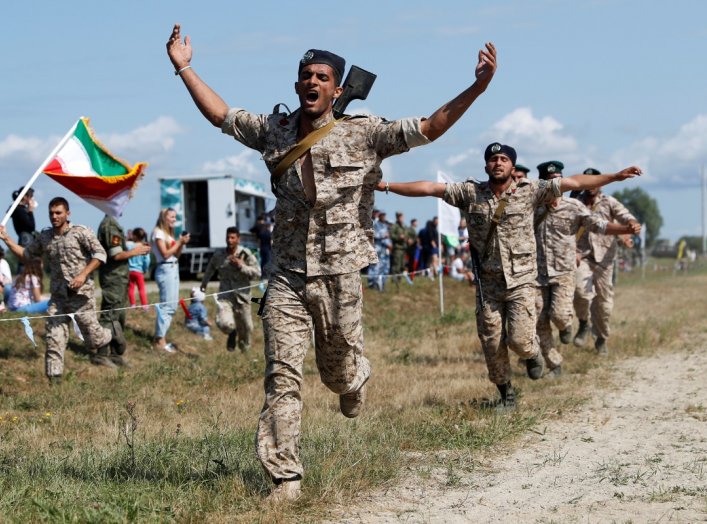
Iran’s sheer size, both in geography and population, are a deterrent to invasion.
One of the most powerful and influential countries in the Middle East is undoubtedly Iran. The Islamic Republic of Iran sits astride several key strategic—and often volatile—regions, including the Persian Gulf, Central Asia, the Indian Ocean and the Caucasus. Iran is primarily a land power, and has invaded and suffered invasion from other peoples and countries over the past several thousand years. As a result, Iran retains large ground forces, both in the Iranian Army itself and the paramilitary Islamic Revolutionary Guard Corps.
The commander in chief of the Iranian Armed Forces is the Supreme Leader, Ayatollah Ali Khamenei. Like many states, there are two armies: the Iranian Army, loyal to the country itself, and the IRGC and its Basij militia, which is loyal to the regime and the spirit of the revolution. Unlike most states with two armies, the Iranian Army and the IRGC suffer from less role and capability duplication, in large extent due to the Iranian Revolution.
The Iranian Revolution of 1979 deposed the monarchy under the shah and imposed a theocratic revolutionary state. The new rulers of Iran, skeptical of long-standing institutions historically loyal to the shah, allowed the Army to survive as an organization but developed the Islamic Revolutionary Guards Corps as a counterweight. While the Army would guard the country’s borders and defend against external threats, the IRGC would guard the regime itself. As a result, the Army was arrayed generally towards Iran’s primary enemies at the time—Iraq, Israel and Saudi Arabia—and placed mostly near the Iranian border. The IRGC, on the other hand, maintains significant garrisons in Iran’s major cities and towns.
In 2013, the Center for Strategic and International Studies assessed the Islamic Iranian Ground Forces as consisting of 350,000 active duty troops, including 130,000 professionals and 220,000 draftees. These troops are organized into four armored divisions, two mechanized infantry divisions, four light infantry divisions, six artillery groups, two special forces/commando divisions, an airborne brigade, three to four commando brigades, an unknown number of aviation units, and other separate armored and infantry brigades.
The ground forces have a number of armored vehicles at their disposal, including 1,663 main battle tanks, 725 reconnaissance and infantry fighting vehicles, 640 armored personnel carriers, 2,322 towed and self-propelled howitzers, and 1,476 multiple rocket launchers. While the sheer amount of equipment sounds impressive, and many pieces, such as the UK’s Chieftain tank, American Sea Cobra attack helicopter and M113 armored personnel carrier, were first-rate weapons for their time, much of it is very dated by 2017 standards. This equipment has been supplemented by Russian equipment purchased during the 1990s to rearm the battle-worn Ground Forces. In general, however, the Ground Forces remain chronically underequipped, crippled by sanctions and a lack of domestic military technology.
Western sanctions and arms embargoes directed against Iran created a vacuum that the country’s nascent arms industry struggled to fill. Today Iran has an enthusiastic, if not quite cutting-edge military-industrial complex. It manufactures a slew of small arms and support weapons for the infantry and offers domestic copies of vehicles such as the BMP-2 infantry fighting vehicle and T-72 main battle tank. Not all of its stated achievements pan out, however; Iran claims to have designed and built the Karrar (“Striker”) main battle tank in just one year, which it says is in some ways superior to the Russian T-90MS it had been attempting to purchase. This is almost certainly untrue.
The IRGC, an equal service alongside the Ground Forces, maintains land forces of its own. The hundred-thousand-strong Ground Forces of the Army of the Guardians of the Islamic Revolution protects the theocratic regime, and as such is more lightly armed than the regular Iranian Army. The Basij paramilitary militia is a lightly armed force also meant to protect the revolution and regime. The Basij infamously acted as poorly trained cannon fodder in the Iran-Iraq War, sending young boys and old men against prepared Iraqi defenses. Today, it is described as a “combination of political party and military organisation” of four to five million that keeps tabs on dissenters and guards the regime.
The most important part of the IRGC, and possibly all of the Iranian Armed Forces, is the Quds Force. Consisting of fifteen to thirty thousand of the best IRGC troops, the Quds Force provides Tehran’s regime with an unconventional warfare capability, broadly similar to the CIA and U.S. Special Forces circa 1967. The Quds Force typically operates alongside nonstate actors such as Hezbollah, providing training, weapons and support. Analysts believe that the Quds Force armed elements of the Iraqi insurgency with IEDs built around explosively forged penetrators, allowing them to penetrate armored vehicles. According to retired U.S. Army general Stanley McChrystal, “We knew where all the factories were in Iran. The E.F.P.s killed hundreds of Americans.”
Much like China’s army in the 1980s, the Iranian Army and other ground forces are large but poorly armed. Iran’s sheer size, both in geography and population, are a deterrent to invasion. With Iraq struggling for its own survival, Tehran’s ground forces generally exist to secure the borders and keep the existing system of government in place. That being said, like the People’s Liberation Army, an injection of funding—and purpose—could turn Iran into the dominant land power in the Middle East.


No comments:
Post a Comment